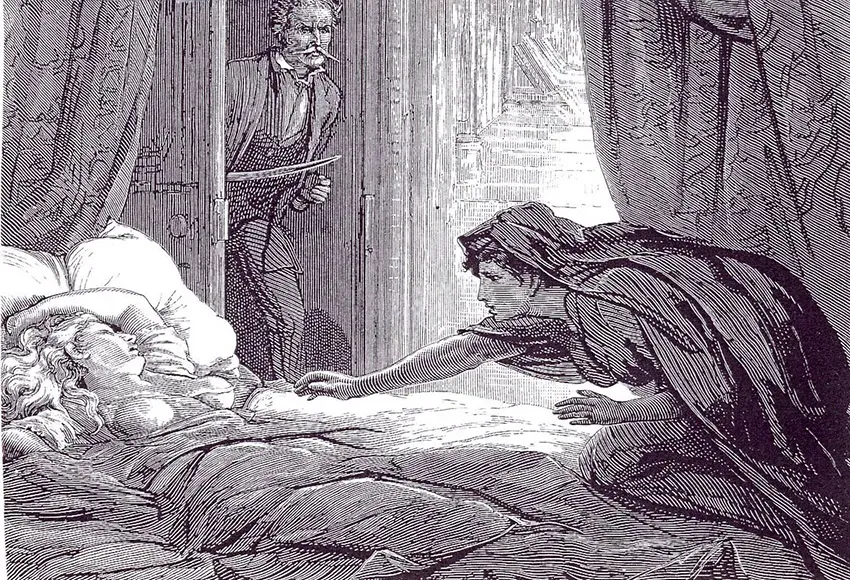CARMILLA
J. SHERIDAN LE FANU
1872
$3.74
73 pages
Content warning: Physical abuse, torture, murder, death
Carmilla is the story of Laura, a lxonely girl whose dad decapitates her only friend because Laura starts sleeping in late.
In more detail: Laura lives in the middle of nowhere in a cheap castle her dad bought. Her mom?: dead (quelle surprise). One day, a traveling noblewoman asks Laura's father if her daughter, who is about Laura's age, may stay with them for a time. Laura, dear sweet Corduroy Laura, has a friend for the first time in her life. A friend who she wishes were a boy so they could bone.
Carmilla's your favorite pretty-boy asshole, the one in salmon shorts and eau de guillotine. At one point, a peasant funeral (of a girl Carmilla killed) passes by and she says, "Who cares? It's a peasant."
Laura's the resident himbo. She explains everything several times before she realizes she's possibly explaining the explanation.
Laura starts waking up with mysterious hickies after someone keeps sneaking into her room at night (Twilight, anyone?). Girls in the local village die suddenly. In the end, the landed gentry realize Carmilla is a vampire, and they dig her up from her tomb to stake her, decapitate her, and burn her bones.
The story is loosely based on Elizabeth Báthory, a countess from Transylvania and supposed serial killer who bathed in the blood of virgins to maintain her youth. However, most likely, Báthory was framed by political rivals in order to destroy her family's influence.
She operated hospitals on her estate – a common practice – and most of the deaths there that could be verified align with plague outbreaks. Most of her ostensible torture, like piercing a person's tongue, tearing skin with red hot tongs, sticking needles under fingernails, and not letting people sleep, were just the torturous medical practices of the time (for abscesses, infected skin, "fingernail poison," and plague, respectively). She also employed a "witch," that is to say, a woman involved in medicine.
Many of the myths that show up in Carmilla seem to be pulled from the folklore surrounding Báthory, such as turning into a cat, bathing in blood in her casket, and hating peasants.
I didn't like Carmilla. It wasn't good in a good way or bad in an interesting one. It was short yet also dragged. Also, although a woman is ostensibly the narrator, let's not kid ourselves that a 19th-century book written by a man would give her any real autonomy or depth. Laura's only role is to be an accessory to her father. Plus, when a male character talks about why he was sad his niece died, it's only because she benefited his dreary life.
In the epilogue, eight years after the book's main events, Laura's again trapped in her father's house with only lingering memories of Carmilla, the only person to ever find her dear. The moral seems to be: be careful of anyone who cares; they probably only want to drink your blood. Which is... a real bummer.

Carmilla was written by a (supposedly) straight man, and it's one of the first examples of their long obsession with Lesbians. I'm going to examine this like a straight man studying Queer relationships: I won't ask any of the subjects, but will immediately jump to outrageous assumptions.
First, men in power hate when women have friends, especially young women, hence why the Bechdel test remains depressingly relevant. The first step of abuse is to isolate the victim, and implying that any close friendship with a woman is dripping with satanic lesbianism is an easy way to do that.
As it happens, in Carmilla, it's extremely easy for the property owner who's kept his sole daughter isolated to declare that her new friend (who has no family to defend her) is actually a horrible Lesbian monster and must be killed.
The second explanation is that men want to be desired but aren't allowed to admit it, since "good women" are supposed to be sexless objects. As frequently happens in Lesbian pulp, women in our heteropatriarchy are not allowed to say yes to sex if they want to keep their reputation intact. So men create a safe way they can interact with a desire-ful woman: by turning them into a monster to be penetrated by the phallic stake.
Maybe men actually desire the equality of a Lesbian relationship, a place to both give and receive pleasure, free from the predefined roles of society and the burden of performing masculinity. Or maybe men want to be part of everything they're not, like when my straight guy friends try to set me up with the one other Lesbian they know.
The most obvious explanation of this and so many other monsters that have caused panic in history – whether it's vampires, witches, or Swifties – is that it's always useful for the dominant class to turn a minority into a convenient villain. And it's best for them when the scapegoat is someone like a young girl who's unable to fight back, despite what her fictional counterpart is capable of.


